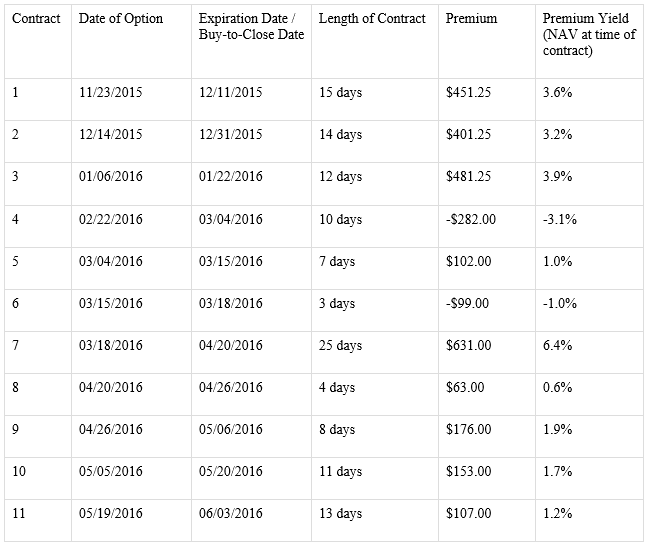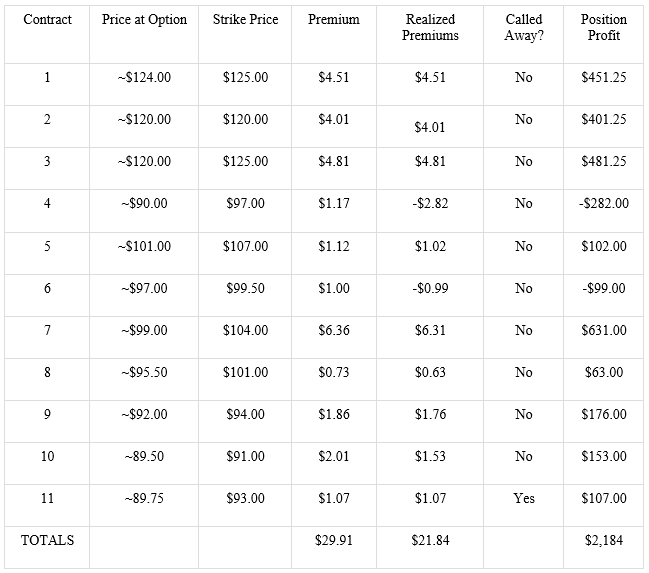Whether you’re investing or trading in Netflix Inc. (NASDAQ:NFLX), it’s difficult to avoid a discussion surrounding an options strategy to augment this position. Netflix has an outrageous valuation and a wide range of intrinsic volatility, where swings of $10-$15 in one day are fairly common. This intrinsic volatility is more so pronounced during any major news story (i.e. expansion into international markets or subscriber price increases) and specifically around earnings announcements. As a result of the nosebleed valuation and volatility, in my opinion, options go hand-in-hand when committing capital to Netflix stock. Netflix is high growth stock thus investors are willing to pay a premium for this growth. However, the tradeoff is that traditional metrics such as the price-to-earnings multiple (P/E ratio) and the PEG ratio do not apply. Due to its rapid growth, expanding original programming, wrestling market share away from big cable companies, expansion into international markets and its overall ubiquity, it's easy to see why investors are willing to pay a premium for this media disruptor. Due to these aforementioned factors, an options strategy may be an effective way to leverage and hedge this high growth stock while mitigating risk. Netflix offers high yielding premiums on a bi-weekly or monthly basis whether one owns the stock or attempting a good entry point. This bodes well for those who are willing to leverage options trading to augment returns and mitigate risk throughout the volatile nature of Netflix’s stock. This could come in the form of covered calls and/or secured puts or a combination of call/put strategy. Netflix’s recent second earnings disappointment highlights the value of an options strategy to mitigate losses and smooth out drastic moves in the stock price.
Note: This article discusses a covered call/covered put strategy to mitigate downside risk and generate income around trading Netflix stock. I provide my real life examples embedded around trading Netflix and its intrinsic volatility. I utilize options to extract additional value out of positions in addition to mitigating risk. I earmark a portion of my portfolio solely for options trading in more volatile stocks. The empirical example demonstrated here is part of my overall options strategy. There are numerous positions that I’ve written covered calls and puts on in which my overall position realized a net loss, despite the options income. I do not want to misconstrue readers into the belief that options are trivial in any sense.
Netflix’s Volatility
Netflix is a highly volatile stock with a 52-week range of $80-$133 per share or a $53 per share range. Layered within that range are swings of $10 per share or more (~10%) throughout the course of any given day. These swings to the upside or downside can be difficult to stomach especially after the most recent earnings announcement where the stock cratered by $15 per share in one day (~$100 to $85). To contend with this volatility, one can leverage his stock or cash position via writing option contracts to mitigate these swings while remaining long or establishing an entry point in this volatile stock. Utilizing biweekly or monthly contacts one can expect to obtain a cash premium of roughly 3%-6% with a strike price that's within 3%-5% of the current stock price (tables 1 and 2). I initiated a position in Netflix at a price of $118.17 and sold a series of covered calls against the underlying position on the downward trend from ~$118 to the high $90s as detailed in below.

Table 1 - Original purchase price $118.17 along with subsequent covered call options contracts

Table 2 - Realized profits expressed net of fees for the covered call contracts
Taken together, leveraging covered calls against my original Netflix position generated a realized income per share of $21.84 in cash while capturing a total option spread of 73% (premiums received – premiums realized). This equates to a realized 18.5% yield ($21.84/$118.17) over the course of ~six months. This strategy has rendered my effective share price to $96.33 at the time of relinquishment ($118.17-$21.84). I reduced my average share price from $118.17 to $96.33 by executing options on my Netflix position. The underlying security was purchased at $118.17 and sold at $93.00 however I realized $21.84 in options income thus my loss was confined to $3.33 a share as opposed to $25.70 per share loss. I mitigated my losses by 87% in this scenario. Details from each option contract can be seen below in Table 3.

Table 3 – Details of each option contract over the past six months
Layering In The Covered Put
I’ve since layered in the covered put side of options as part of my options strategy. This simply stated, yields a situation where I sell a put option and receive a premium in exchange for the obligation to buy the shares at a specified price by a specified date. The most recent contact that I sold was a covered put at a strike price of $105 in exchange for $10.16 per share at a time when the shares were ~$100. My thinking was, given the timeframe at the time of the contract that Netflix would appreciate beyond the $105 level by mid-August and I would free up the cash I had earmarked for the covered put and capture the $1,016 in cash premium. An alternative line of thinking was that in the event the stock remained above $95 then I’d acquire the shares at a gain since my effective share price would be $94.84 ($105 strike less the $10.16 premium).
Delving Into The Numbers
I originally purchased the shares at $118.17 and wrote covered call contacts until relinquishment that generated a net income of $21.84 per share rendering my average share price to $96.33. I relinquished my shares at $93.00 per share thus $9,300 from the underlying equity plus $2,184 from options premiums equates to $11,484 total. Taken together, money going into Netflix was $11,817 and money coming out Netflix was $11,484 or a $333 loss (-2.8%) compared to a loss of $2,517 (-21.3%) had I kept the shares and sold them at the same price. At the point of relinquishment, I’ve now reset my position with a loss of $333 from my original principal amount invested. I recently sold a covered put for $10.17 per share at a strike of $105 therefore if the shares get assigned I will have acquired the shares at an effective share price of ~$95. Alternatively, if the shares are not assigned I will have made a 9.7% return do to the premium divided by the amount of cash I earmarked for the contract ($10.17/$105). If the shares are assigned then I will begin to write covered calls against these shares as I did before.
Writing Options At Risk Into Earnings
In March, Netflix was stuck in a tight trading range between $90 and $100 per share. I decided to write a covered call when the stock reached $99 per share with a strike at $104 per share with an expiration date of 04/22/2016. Netflix was due to report earnings on 04/18/2016 just prior to the expiration of this contact. I wrote the option at risk knowing that if the earnings report turned out to be positive, the stock would likely fly much higher than the strike of $104. Due to the ~6.5% premium yield and accounting for the built-in upside of $5 per share I would be effectively paid $110.36 per share. However, I was writing this option at risk due to the increased uncertainty surrounding the upcoming earnings report. The earnings report would either move the stock up or down in a dramatic move. I wanted insurance in the event the report turned out to be negative and fortunately for me this strategy worked out well. In early July, Netflix had been trading between $90 and $100 as well and knowing that earnings would be announced in the back half of July, I decided to sell a covered put. This is a bullish sentiment as I didn’t think Netflix would report two consecutive bad quarters.
Considering the stock was in the mid $90s and the contact expired in mid-August I felt that $10.17 per share was too good to pass up. I felt that I had enough time after earnings to bounce back if the results were poor and if they beat earnings, I would’ve made a 10% gain on that cash I earmarked to buy the shares at $105. As it currently stands, it appears that I’ll be assigned the shares at $105 less the premium of $10.17 for an effective share price of ~$95. The current price as of this writing is $88 so I would initiate my position with an unrealized loss of 7.4% assuming today the contact would be exercised.
Summary
Whether you’re investing or trading in Netflix Inc. (NASDAQ:NFLX) it’s difficult to avoid a discussion surrounding an options strategy to augment this position. As a result of the nosebleed valuation and volatility, in my opinion, options go hand-in-hand when deploying capital into Netflix stock. Due to Netflix’s intrinsic volatility, an options strategy may be an effective way to leverage and hedge this high growth stock while mitigating risk. This could come in the form of covered calls and/or secured puts or a combination call/put strategy as I outlined above. Netflix’s recent string og earnings disappointments highlights the value of an options strategy to mitigate losses and smooth out drastic moves in the stock price.
Thanks for reading,
The INO.com Team
Disclosure: The author holds shares in AAPL, AMZN, DIA, GOOGL, JPM, MSFT, QQQ, SPY and USO. The author has no business relationship with any companies mentioned in this article. This article is not intended to be a recommendation to buy or sell any stock or ETF mentioned.
